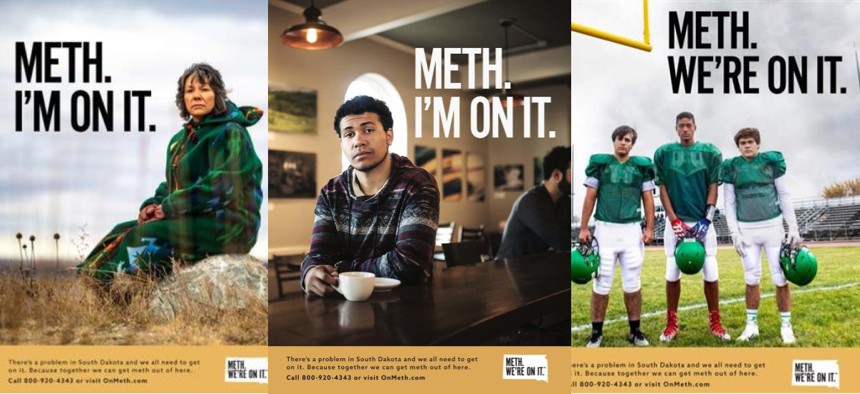‘Meth. We’re On It.’ Ad Campaign in South Dakota Gets Attention

An anti-meth campaign kicked off in South Dakota this week is using an unusual tagline: “Meth. We’re On It.” South Dakota Department of Social Services
The slogan went viral on Twitter when users commented that the ads missed the mark. State officials say the discussion the campaign prompted is exactly the point.
An anti-meth campaign kicked off in South Dakota this week is using an unusual tagline: “Meth. We’re On It.”
The public safety campaign is part of the state’s push to raise awareness of how widespread methamphetamine use is in the state. The slogan, which is meant to encourage all South Dakotans to “band together” to combat meth use, was quickly ridiculed by Twitter users across the country.

Most pointed to the obvious—that showing pictures of state residents next to the slogan “Meth. We’re On It.” implied that those in the photos—football players, a rancher, and others—were using the drug.
Rejected options included “Meth: Just Do It” “Meth: for Real Men” “Meth: Fun, Cheap, Wacky” “Meth: Bringing Families Together” “Meth: You Should Buy Some and Use It” and “Got Meth?” https://t.co/0d9IcPwVj5
— J. Kru (@JeridKru) November 19, 2019
The state is using the phrase “we’re on it” to mean “we’re doing something about it.” When the slogan is next to individuals, “the impactful visuals of real South Dakotans” are meant to “powerfully tell the story that meth is everyone’s problem,” reads a press release about the campaign. “Because meth affects everyone, and we need everyone to beat it,” reads the new website for the campaign (OnMeth.com).
Others questioned the price tag of the campaign, which cost the state about $450,000. Kim Sue, the medical director for the Harm Reduction Coalition, a national group that advocates for practices that prevent overdoses, disease transmission, and the incarceration of drug users, tweeted that the money could have been better spent. “Imagine 450K put into harm reduction for meth in South Dakota,” she wrote, adding that the state could have invested in things like syringe exchanges, safe injection sites, or to expand Medicaid insurance coverage, which would allow for more drug treatment.
The consulting company that devised the ad, Broadhead, is contracted with the state until May 2020 to produce “an effective South Dakota specific media campaign that increases awareness of methamphetamine use and promotes resources for prevention, treatment and recovery.” The campaign includes billboards, radio ads, TV commercials, social media posts.
In a statement emailed to Route Fifty, Beth Burgy, the president of Broadhead, said that the company is proud of its work. "The campaign is doing its job. It’s generating conversation, it’s soliciting all kinds of reactions and, yes, it’s making people uncomfortable. But discomfort causes change and demands action. This campaign is the necessary first step to initiate change and start conversations surrounding meth use," she wrote.
The website for the campaign encourages residents to “stand up against meth” in their communities and offers resources for prevention and substance abuse support. The site offers suggestions for three means of engagement: in communities, in schools, and in the home.
Schools have been a particular focus of the fight against meth in South Dakota, as one survey showed that 4.8% of ninth graders in the state have tried methamphetamine, more than double the nationwide rate of meth use at that age.
The state has also cracked down on meth usage via arrests and drug seizures. In 2018, law enforcement made 3,684 arrests for methamphetamine and seized 45,918 grams of the drug. In 2019, 83% of court admissions for controlled substances were methamphetamine-related.
The state has been criticized in the past for its use of incarceration to deal with its drug problem, and the new campaign sparked some of the same debate. The American Civil Liberties Union of South Dakota tweeted that “tough-on-crime policies can't fix society's problems—especially in regards to addiction” in response to the campaign.
But South Dakota Gov. Kristi Noem, a Republican who took office this year, said the number of arrests and deaths due to meth usage spurred the state to act. “These numbers are more than just statistics. They’re missing faces. Empty chairs. Meth is an epidemic in our state, and we ALL need to pay attention. Let’s get on it,” she tweeted.
On social media, Noem seemed to take the criticism of the campaign in stride. She noted that the “whole point of this ad campaign is to raise awareness,” saying it therefore is achieving its goal.
Laurie Gill, the state’s secretary for the Department of Social Services, the agency running the campaign, agreed that the point was to get attention. “We are looking for a way that would cause the citizens to stop, pay attention and understand that we do have a meth issue and that there are resources available,” she told the New York Times. “That was the tone going into it, looking for something that would be edgy and that would be able to cut through clutter in advertising and social media.”
David Jarman, a contributing editor at the Daily Kos, suggested that the state might not be as clueless as some asserted online. “I hope you've all figured out that South Dakota's ad agency knows exactly what it's doing and you're giving them the attention they wanted?” Jarman wrote. “If their slogan had been of the "Don't do meth; it's bad for you" ilk literally no one would be aware of SD's anti-meth campaign today.”
Noem responded to the tweet with one word: “Exactly!”
This article has been updated.
Emma Coleman is the assistant editor for Route Fifty.
NEXT STORY: The Startlingly High Cost Of The ‘Free’ Flu Shot






